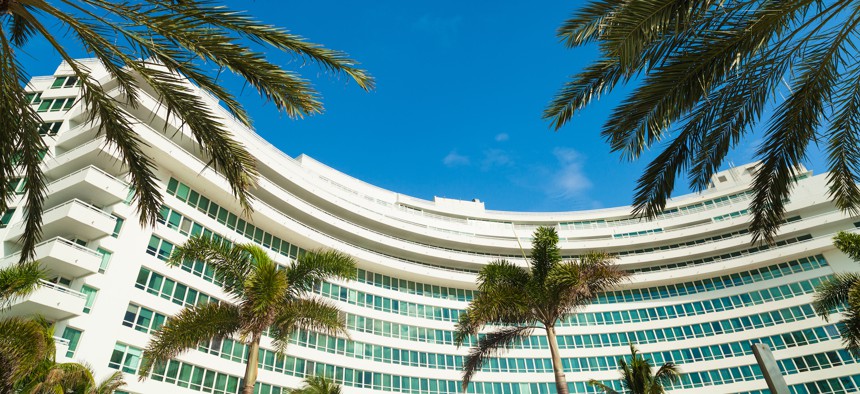What to Watch For as U.S. Mayors Meet in Miami Beach

Fontainebleau Hotel Shuterstock
There are some big political and policy moments we can expect at the 85th meeting of the U.S. Conference of Mayors.
MIAMI BEACH, Fla. — The U.S. Conference of Mayors last meeting, held in the nation’s capital in January in the days leading up to President Trump’s inauguration, had an air of the unknown. At that time, numerous mayors had shuttled to Trump Tower in New York City to discuss issues including infrastructure, immigration and the tax exemption on municipal bonds.
Five months later, these key issues and many others still hang in the balance. Here are some key moments and issues you can expect to take center stage when the members of the U.S. Conference of Mayors convene for their 85th annual meeting at the Fontainebleau Hotel.
Higher Office Buzz
With a Democratic Party that has not had much luck in federal and statewide offices, mayors are the life of the party—and quite a few Democratic mayors in attendance are the subject of higher office buzz.
Los Angeles Mayor Eric Garcetti has been eyeing the California governorship but also has been approached by donors about a potential 2020 presidential run.
Nan Whaley, mayor of Dayton, Ohio, has already announced her intention to challenge Gov. John Kasich in 2018. Mayor Pete Buttigieg of South Bend, Indiana, is also getting questions about what he might run for next after a strong, but ultimately unsuccessful, run for chairmanship of the Democratic National Convention.
Perhaps no one is getting more national buzz right now than New Orleans Mayor Mitch Landrieu, who will ascend to the presidency of the U.S. Conference of Mayors in Miami and has been mentioned for higher office, as well. After removing major Confederate monuments from prominent places across the city, Landrieu gave an eloquent and powerful speech on race and the veneration of the Confederacy in the South.
Landrieu’s second term as mayor ends later this year, and since New Orleans has a limit of two mayoral terms, he’ll be looking for new employment and perhaps eyeing higher office.
A Blunt Discussion on Infrastructure
At the winter meeting, just prior to inauguration, then Vice President-elect Pence told the assembled mayors that Trump had asked him to relay a message: ‘Tell them we’re going to do an infrastructure bill, and it’s gonna be big.”
No legislative proposal has yet been shared, although the administration has said the plan will favor state and local governments with money lined up and focus on public-private partnerships.
This time around, D.J. Gribbin, special assistant to the president for infrastructure policy, will sit down with Oklahoma City Mayor Mick Cornett and Los Angeles Mayor Eric Garcetti.
Gribbin is widely recognized as the leading voice for the administration on infrastructure and is expected to take questions from the mayors in attendance.
What we know, and what we don’t know, about the administration’s infrastructure plan is enough to stimulate strong debate. While major urban areas with substantial growth and matching funds can attract private investment, rural areas and those that may be most in need of investment—having little capital to stimulate their economy—may not be so lucky.
There are also still questions of what, exactly, the administration is defining as infrastructure.
The president’s budget would allocate $5 billion to the program in the upcoming 2018 fiscal year. That spending would then increase to at $50 billion in 2021, before gradually sinking back to $5 billion in 2025 and 2026.
Trump Cabinet: Who Is Coming and Who Isn’t
The U.S. Conference of Mayors will also be joined by Labor Secretary Alexander Acosta and Veterans Affairs Secretary David Shulkin.
Expect Acosta to talk about President Trump’s executive order to expand apprenticeships and vocational training, as well as the removing regulations the administration believes stymie business growth. There will also probably be a few mentions of the health jobs reports we’ve seen thus far in 2017.
Shulkin is likely to focus on how mayors and federal entities can work together to support veterans. With Veterans Affairs looking to close more than 1,100 facilities across the United States, many mayors may have some questions about how such closures might impact their hometown.
Perhaps most noticeable is which secretaries are not in attendance. At a time when Community Development Block Grants are on the chopping block, Housing and Urban Development Secretary Ben Carson is most notably missing.
Bill Clinton’s Keynote
President Bill Clinton has kept a relatively low profile since his wife, Hillary Clinton, lost her bid for his former job in November. He will now take the stage this weekend during a plenary session before the U.S. Conference of Mayors, and he is likely to find a friendly audience.
What Clinton will talk about is less certain. On Tuesday, Clinton opened a conference for InterAction, an alliance of U.S.-based international nongovernmental organizations. His 50-minute speech that hit on everything from climate change and humanitarian aid to domestic crime rates and immigration.
A Bloomberg Appearance
Michael Bloomberg, former mayor of New York City and philanthropist, will also be a presence at the conference.
Bloomberg has been an active booster of mayors acting both locally and globally. He has promoted data-driven solutions across the United States through his What Works Cities initiative and earlier this month helped launch a new environmental alliance called “We Are Still In” to step into climate leadership roles internationally after the administration withdrew from the Paris Climate Accord.
Bloomberg Philanthropies has also launched numerous mayors challenges both domestically and internationally to focus on civic innovation. Will Bloomberg bring a new initiative or challenge to the members of the conference?
Strong Words Against State Preemption
With the urban-rural political divide particularly pronounced this cycle, mayors are feeling particularly isolated politically from not only the national agenda but also their statehouses.
As urban areas pursue policies reflecting the values of their citizens, it's often met with preemption of at the state level. From actions to curtail funding from “sanctuary cities” to preemption of local protection of sexuality and gender, there are a number of cultural and financial clashes going on between mayors and their state counterparts.
These battles have become regular nationwide and will be a key topic of discussion.
Stronger Words Against the Trump Administration
Finally, there will be no lack of strong words against the Trump administration’s actions. Whether on immigration, healthcare, climate change, or proposed cuts in domestic spending, the mayors see crucial dollars and policies being scaled back.
These actions will have real consequences for how mayors govern in 2017 and beyond.
Mitch Herckis is the senior director of programs for Government Executive’s Route Fifty and is based in Washington, D.C.
NEXT STORY: A New U.S. House Task Force on Intergovernmental Affairs Begins Its Work






